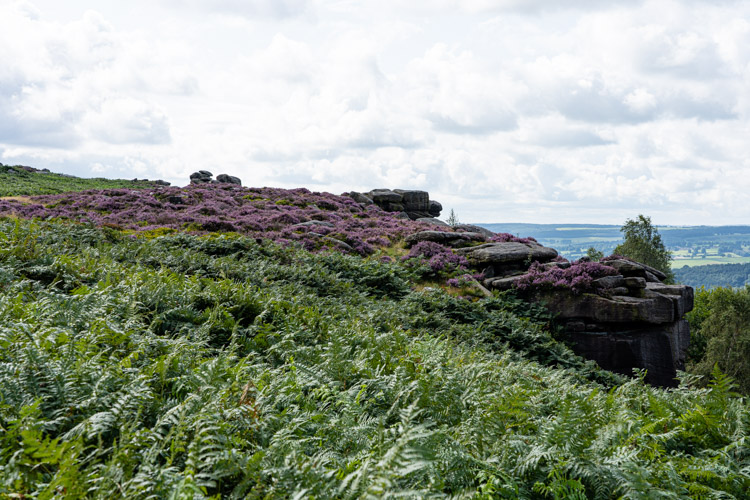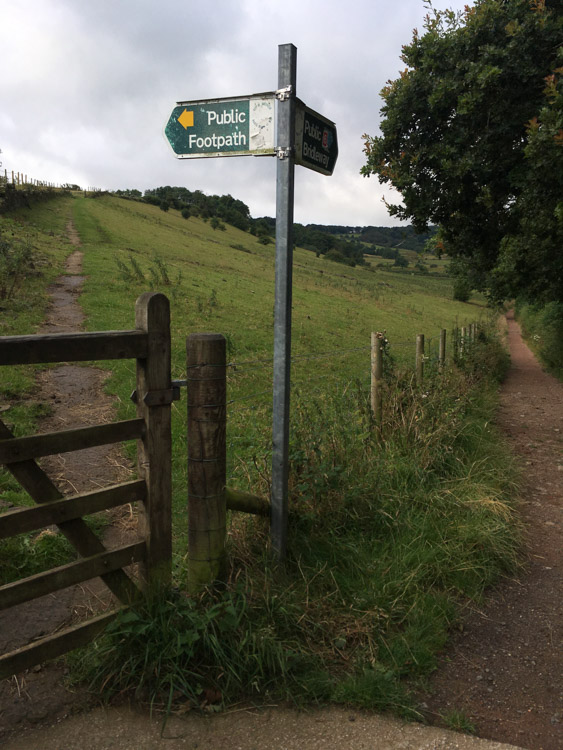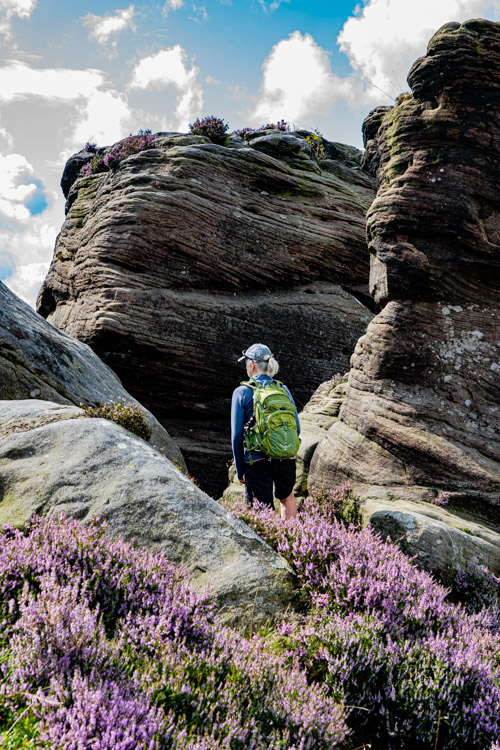

Drive south out of Sheffield on the A625 and there’s a point, just as you leave behind the buildings, when the road swings and your vision is filled with hills ahead of you. At this time of year they are glorious with the pink and purple of heather and the bright green of bracken. Behind, Sheffield lies nestled in its river valleys, ahead the moors leading into Derbyshire and the Peak District. It’s fifteen minutes since you left the inner suburbs.
This is one thing I miss about the city in which I grew up. In a short time you can be out in the countryside where there are a multitude of tracks, paths and bridleways leading over hills, into valleys, along the tops of the many Edges that line this land. Even walking from where we are staying (close to where we lived) we would soon come to a choice of public footpaths through woods and fields. There is no such thing as a public footpath in the New Zealand countryside and a junction where there is a choice is rare.

Walking through the woodlands of the Porter Valley*, an area we know well and I’ve been visiting since childhood, I still see new paths leading from familiar ones. There are more options for cycling – when we lived here it was forbidden through these woods, now it is allowed on bridleways and signs point the way to the Peak District.
So it is that a forecast of wind and rain doesn’t stop us from driving out of the city. We park on the roadside – a barrier prevents us entering the car park at the National Trust estate at Longshaw, a sign saying the estate is closed ‘because of high winds’. The Wellingtonian in me tuts and shakes my head – it’s hardly more than a stiff breeze. I wonder if the barrier and the sign is against anyone injured by wind-blown debris taking a lawsuit as they weren’t warned of the risks. Living in New Zealand (where a government agency exists to avoid such litigation) it’s easy to forget that this is possible.

We walk where millions of others have, along Froggatt and Curbar Edges (where one ends and the other begins I have no idea), on paths that were important packhorse routes centuries ago, harsh and challenging in wild weather. Drizzle and light rain accompany us, the views hazy through it. On a clear day you can see across the valley towards Eyam on the side of Sir William Hill, crags visible amongst the trees, probably marking the clough where the villagers held open air church services during the plague in an attempt to avoid spreading the disease. In the valley a line of trees marks the path of the River Derwent, the same that runs under the bridge at Slippery Stones high on the moors, here wider and deeper. An old mill, now converted to apartments, stands tall alongside. Beyond, the hills roll and rise into the distant peaks of the Pennines.

Dark granite rocks, some layered in pancake stacks where centuries of weather has worn away lighter rock, peep up from the Edges, clustering in groups. In the wet they shine silvery; in fine weather climbers dangle from rope and rock. Bright pink heather glows in cracks and carpets the ground alongside vivid green bracken, the scourge of hikers in shorts, harsh fronds scraping skin.
At a gap in the rocks a path leads down through woods of silver birch and young oak, a mountain ash heavy with berries. It’s rough and rocky but easy enough to traverse and we are soon alongside the Derwent. By the weir the walls of a cottage sink below the river level, a window only inches above the water line. I would worry about flooding if I lived there but maybe the reservoirs upstream control the flow enough that this river doesn’t. In the villages cottages with large, well-tended gardens and expensive cars in their drives line the road. You need a lot of money to live in a Peak village nowadays, not to mention a knack for gardening (or the money to pay someone else to do it for you).

A stile takes us into and across fields, passing sheep that barely notice us, through muddy gateways and into woodland on a stone path that has either been there for decades or has been so well laid as to look as though it has. It leads us into the village of Grindleford and a sign for the Sir William Hotel that makes me smile. Instead we stop at the local community café for tea and cake, being invited to sit in the church as the rain looks likely to return. It’s a first for us and the group of half a dozen other hikers who, sitting on rearranged pews, have ‘never had tea in a church before’.

As we leave the rain gets serious, forcing us to pause to cover our backpacks. We climb through the woods, rain drumming on hoods and dripping from coats onto shorts. At least it cleans the mud from our boots! In only a couple of hours we’ve gone from walking through boulders on a wild rocky Edge to woodlands with dripping trees and tumbling streams, through fields of indifferent sheep and two pretty villages. I don’t know anywhere else we could do that.

*The Porter valley deserves more than a quick mention. It is one of five Sheffield rivers where scores of craftsmen, Little Mesters, used to ply their trades – primarily tool and knife making, later rough forms of cutlery – as far back as the fourteenth century. Remnants of their toils remain, mainly in the form of small reservoirs, or dams, leading to wheels that were turned by water and powered their grindstones. Most are derelict and merely a shadowy reminder of a pre-industrialised past, but some still remain: Shepherd’s Wheel has been renovated since I left the city and the wheel once again runs smoothly, turning belts and cranks in the workshop, evoking a time when it was in daily use, thankfully without the choking dust that made life hard and generally short. Forge Dam is slowly being restored, silt removed and wildlife re-introduced. The café does a mean parkin and a decent cup of tea.

Beautiful place! The rock formations look cool, and the lavender colored flowers are gorgeous!
LikeLike
It is! I urge you to visit if you get the chance.
LikeLiked by 1 person
Boy you really timed it for the heather! Clever you. Gosh it really is beautiful. It makes me want to go visit. The Secret Garden where the moors featured is one of my favorite books. To say nothing of Wuthering Heights.
LikeLike
I can see you here – with your hair and your beautiful fine features you are Cathy.
LikeLike